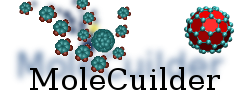Changeset 66872e
- Timestamp:
- May 18, 2017, 7:14:56 PM (8 years ago)
- Branches:
- ForceAnnealing_goodresults, ForceAnnealing_tocheck
- Children:
- 396aab
- Parents:
- b94e74
- git-author:
- Frederik Heber <heber@…> (03/01/17 20:34:07)
- git-committer:
- Frederik Heber <frederik.heber@…> (05/18/17 19:14:56)
- File:
-
- 1 edited
-
doc/userguide/userguide.xml (modified) (2 diffs)
Legend:
- Unmodified
- Added
- Removed
-
doc/userguide/userguide.xml
rb94e74 r66872e 2090 2090 <section xml:id="potentials.fit-potential"> 2091 2091 <title xml:id="potentials.fit-potential.title">Fitting empirical potentials</title> 2092 <para>Empirical potentials are function that represent a certain aspect 2093 of binding forces in molecular dynamics, e.g. a bond potential represents 2094 the force between two atoms arising because of a binding orbital in 2095 between that may be (in some approximartion) represented by a Hooke's 2096 spring law. 2097 In a more abstract view, an empirical potential consists of the 2098 following: a binding model representable as a graph consisting of nodes 2099 and edges, a function that takes the distance between nodes and the 2100 set of edges (representing bonds in the binding model) and last but 2101 not least a set of parameters that represent the respective strength 2102 of the bonds. For example, a torsion potential has a binding model 2103 containing four nodes and three edges connecting node 1 and 2, 2 and 2104 3, and 3 and 4. The function requires the six interatomic distances. And 2105 the parameters are coefficients in the functions that need to be 2106 evaluated to obtain the resulting force vector. 2107 </para> 2108 <para>In this manner, empirical potentials are implemented in 2109 MoleCuilder. They are not just a function but always an additional 2110 binding model that allows to associate atoms with a specific node 2111 in the model and thereby to assicate it with a particular interatomic 2112 distance. And said model determines in what order the elements have 2113 to be given. 2114 </para> 2092 2115 <para>Let's take a look at an exemplary call to the fit potential 2093 2116 action.</para> … … 2103 2126 we want to look at. Here, obviously we are interested in water 2104 2127 molecules, consisting of a single oxygen (8) and two hydrogen atoms (1). 2105 Next, we specify the chemical element type of the potential, here a potential between oxygen (8) and hydrogen (1). We give 2106 the type of the potential as morse, which requires a single distance 2107 or two nuclear coordinates and the distance taken between the two. Finally, we state that the non-linear regression should be 2108 done with five random starting positions, i.e. five individual minimizations, and the set of parameters 2109 with the smallest L2 norm wins.</para> 2128 Next, we specify the chemical element type of the potential, here a 2129 potential between oxygen (8) and hydrogen (1). We give the type of 2130 the potential as morse, which requires a single distance or two 2131 nuclear coordinates and the distance taken between the two. Finally, 2132 we state that the non-linear regression should be done with five 2133 random starting positions, i.e. five individual minimizations, and 2134 the set of parameters with the smallest L2 norm wins.</para> 2110 2135 <note> 2111 2136 <para>Due to translational and rotational degrees of freedom for 2112 2137 fragments smaller than 7 atoms, it is appropriate to look at the 2113 pair-wise distances and not at the absolute coordinates. Hence, 2114 the two atomic positions, here for oxygen and hydrogen, are 2115 converted to a single distance. If we had given an harmonic 2116 angular potential and the then required three charges/elements, "8 1 1", i.e. oxygen 2117 and two hydrogens, we would have obtained three distances.</para> 2138 pair-wise distances and not at the absolute coordinates. In the 2139 case of the water molecule as a the fragment whose energy we 2140 want to represent by a empirical potential, there are 3 atoms 2141 and therefore 3 unique distances between any pair of atoms. 2142 From this set of distances MoleCuilder needs to pick any subset 2143 that matches with the ones required by the binding model. 2144 In our case of the Morse potential, we need two atoms, oxygen 2145 and hydrogen, i.e. a single distance. If we had given a harmonic 2146 angular potential and the then required three charges/elements, 2147 "1 8 1", i.e. oxygen and two hydrogens, we would have 2148 obtained three distances. The order of the elements, i.e. 2149 "8 1 1" would match a different angular interaction 2150 in the same fragment, depends on the binding model of the 2151 potential. In the case of the harmonic angle, the second element 2152 in the list is the central atom in the angle, while the first and 2153 third atom define either arm of the angle.Naturally, for the Morse 2154 potential the order does not matter as each distance is symmetric. 2155 </para> 2118 2156 <para>MoleCuilder always adds a so-called constant potential to 2119 2157 the fit containing only a single parameter, the energy offset. 2120 2158 This offset compensates for the interaction energy associated with 2121 a fragment of order 1, e.g. a single hydrogen atom. Essentially, this captures the atomic energy that is not associated to any bonding interactions.</para> 2159 a fragment of order 1, e.g. a single hydrogen atom. Essentially, 2160 this captures the atomic energy that is not associated to any 2161 binding interactions.</para> 2122 2162 <para>Note that by choosing "set-max-iterations" and "take-best-of" 2123 2163 one can force the optimization to try either a single set of random
Note:
See TracChangeset
for help on using the changeset viewer.
